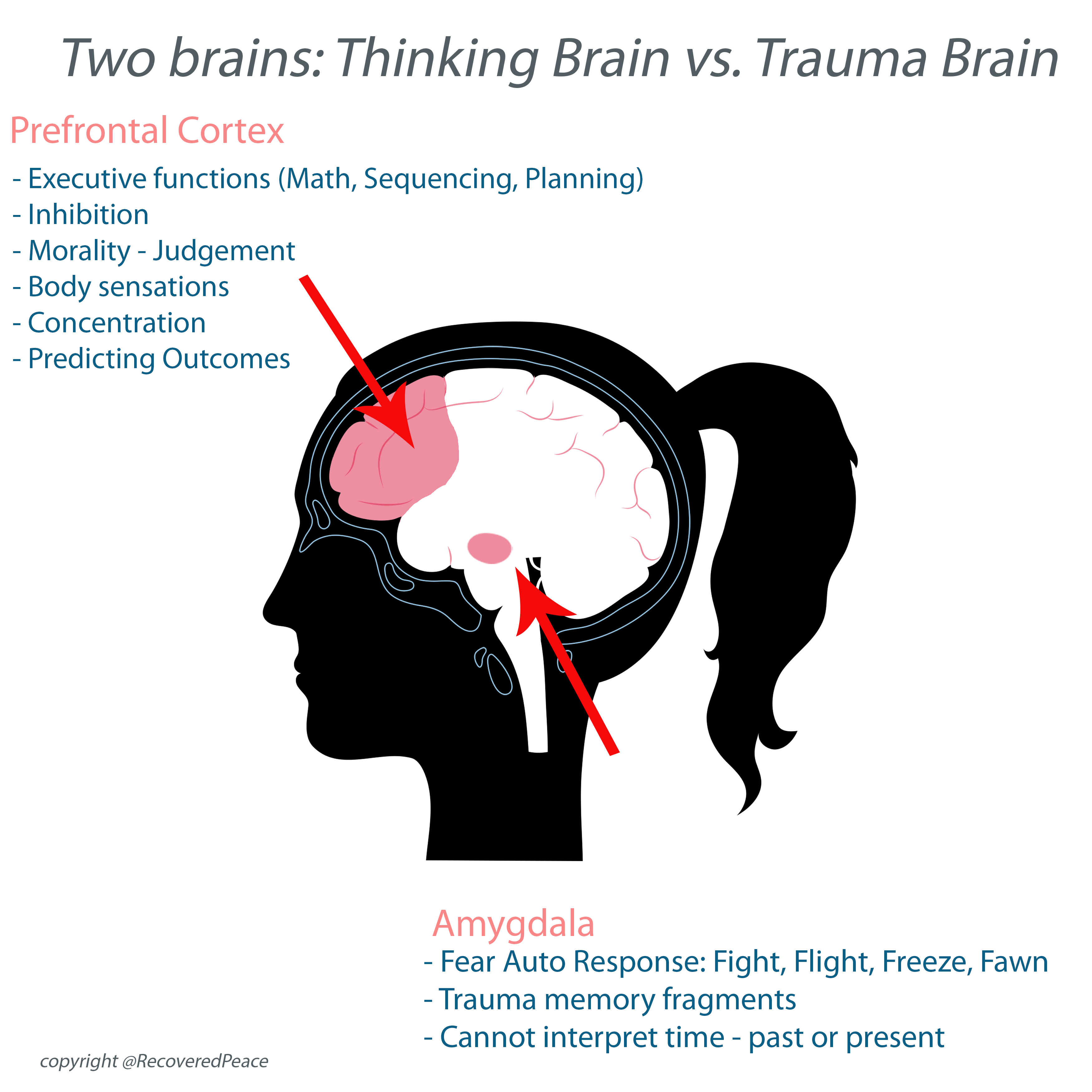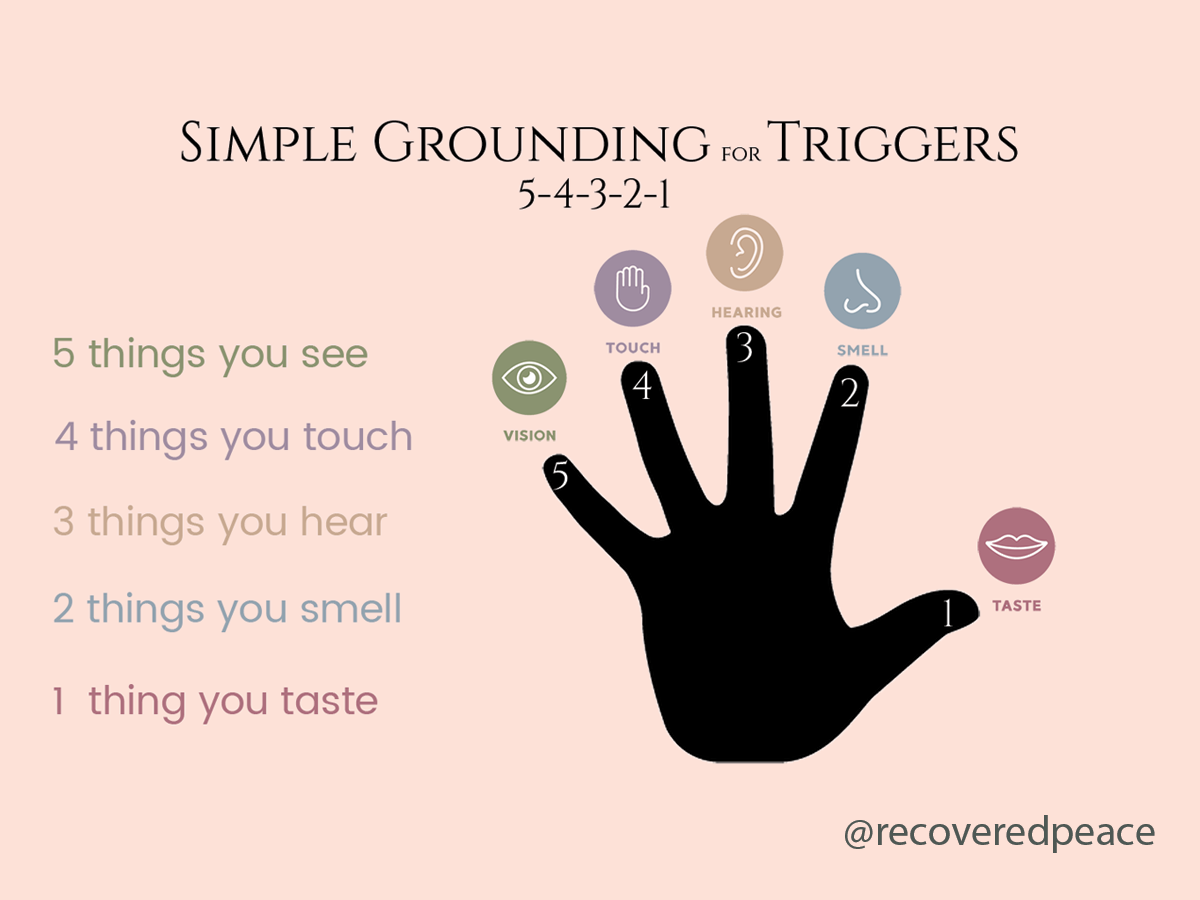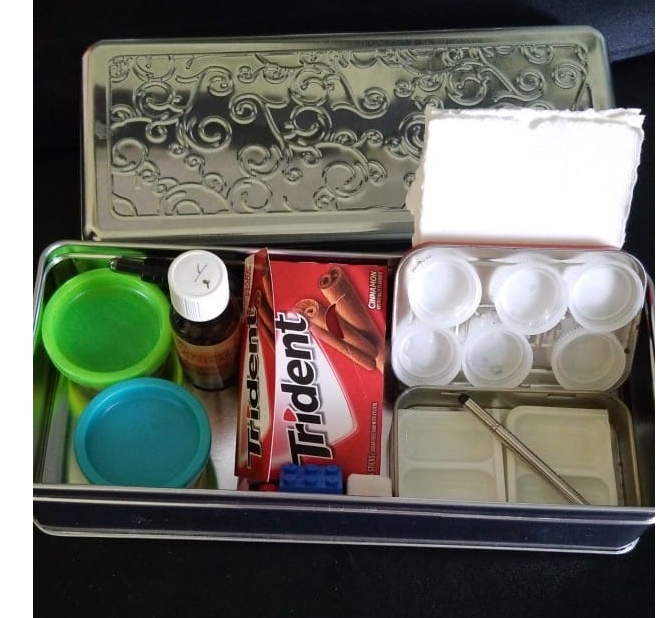Trigger Tools
Betrayal trauma brings “panic attacks” or feeling “triggered”, extreme sadness, extreme fear – all symptoms of betrayal trauma, or left untreated becomes PTSD.
It's a function of the brain – trauma is activated and stored in the part of the brain called the amygdala. That part of the brain feels extreme emotion: fear, panic, sadness, anxiety, distress, hopelessness.That part of the brain is not able to process time or sequencing, which is why when you're triggered, if feels like it will ALWAYS be this way, or that you will never be free of these feelings. Your brain is lying to you!
We need to draw energy away from that part of the brain, into the prefrontal cortex, where logic, time sequencing, ‘executive functioning' (managing yourself, self-regulation) and sensory functioning (taste, smell, hearing, seeing, tactile).

The following actions will help you get more into your prefrontal cortex and help your brain “calm down” from the trigger. It can take about 20-30 minutes or more for those brain chemicals to subside.
*Note – we can also experience grief waves, which are similar to triggers and can feel overwhelming but are quite different. Here's an APSATS podcast/video on grief in betrayal trauma.
Member tips:
-
- Grounding: in a triggering situation I’ve learned to feel the bottom of my feet. If my feet are not touching the floor, I put them on the floor (if I can) to *ground* myself. It has helped tremendously.
Wiggling your toes is a simple way to do this, wherever you are. - Breathing: Navy Seal Panic Attack Breathing: 4 seconds in. 4 seconds hold. 4 seconds exhale. Pause. Repeat. (Apparently rewires your brain chemicals.)
I inhale as slow as I can, hold it as long as I can, then let it out as slow as I can, making the “ahhhh” sound. - Anything that Engages the body senses:
- Sight
- Smell
- Taste
- Tactile
- Hearing
- Sight: I have a drawing app on my phone, I have a portable watercolor set and so I will draw or paint what I feel or what I want to feel. I will go to pinterest, or instagram and focus on the artsy folks that I follow.
- Trigger Toolkit to engage the senses and stimulate prefrontal cortex energy, away from the amygdalaHearing: Having a playlist of calming or inspirational music already on my phone or computer, and earbuds.
I have calming music on my phone (and my computer) that i can listen to on my headphones, I need to really, really focus in and listen to the layers of music. I also listen to inspiring worship music, or chanting. - Depending on what works that day.
- Taste: I have cinnamon gum, and I focus on the taste, how it makes my tongue feel. If I don't have gum at the moment, I try to focus on what I can currently taste in my mouth. Is it salty, sweet, acidic, etc?
- Smell: I focus on what I can smell. I keep a bottle of essential oil in my purse. Lavender and Ylang Ylang are calming for me. Sandalwood and frankincense help me feel grounded.
- Tactile: I keep Playdough in my purse. No kidding! I also like polymer clay. I knead it, roll it into balls, make faces with it, make a heart and break it in two. Focus on the temperature, texture, color, smell.
Personally, I like silly putty because it won’t dry out. - Body sensations: Hot bath, with a candle and soft music also helps. Taking a walk, getting outside.
In the body: Hot shower, warm bath, massage, walk, yoga, exercise, martial arts, weight lifting. Anything that forces your brain to experience your body. - My daughter's therapist taught us the 54321 method.
5 things you can see
4 things you can hear
3 things you can touch
2 things you can smell
1 thing you can tasteWe have the list taped up in our bathrooms because it seems to be everyone's hide and freak out spot.
- Grounding: in a triggering situation I’ve learned to feel the bottom of my feet. If my feet are not touching the floor, I put them on the floor (if I can) to *ground* myself. It has helped tremendously.
- Trigger Toolkit: Here's part of my trigger tool box to help my brain go into “sensing” mode instead of “emotion” mode. More of it, is on my phone.(playlists, podcasts, journaling app, bible apps, meditation apps, drawing/painting apps). Playdough (tactile), Ylang Ylang essential oil (smell) Cinnamon gum (taste) mini watercolor kit (tactile, visual, art therapy), Pen to write with, lego blocks to remind me that trust and recovery is built one small block at a time.

- Prayer – of course, needs no explanation. Call God into your presence. He gets it. Scripture – there's so many promises, and it's important to remember how GOD sees you, not how we see ourselves, or anyone else sees us.
- Problem solving out loud: talking to yourself is actually a good thing! Learned from my son's therapist today that there's 2 parts of the prefrontal cortex that can solve problems. One part can do problem solving in the brain, like math, 2+2=4. Other problems that are more complex is helped by speaking the problem out loud. Saying the problem, helps move it to the part of the brain that's dedicated to solving problems.
- I have been counting backwards from 100 whenever I find myself ruminating then starting to cry. I find that, for now anyway, I am calmer by about 65. Especially helpful when I am in public…like at work. Wearing a mask only hides so much.
- A tool I use when spiraling into unwanted thoughts is I name 5 yellow things around me (or whatever color). I also “ground” myself and name 5 physical things I feel at that moment. Butt in seat, hair on face, rings on fingers etc. doing these interrupts the negative thoughts and helps me.
- Forcing the prefrontal cortex to take over with executive functioning tasks: when my thoughts become very destructive and dark, I have started trying to do the alphabet backwards (possible with practice) or the 7 and 8 times table, for like 20 min. The harder the brain task the better.
- Read: read recovery material – scripture, SA partner recovery stuff, S-Anon stories, boundary stuff, workbooks, blogs, articles.
- Verbal functioning: I write what I'm feeling. I try to use the feelings wheel so it's very focused on me. Engaging the verbal part of the brain moves the feelings from the trauma brain to the prefrontal cortex. You have to name it, to tame it. You have know what you feel so you can make boundaries from that. You have to know what you don't like feeling, so you can name what you WANT to feel instead. (Another thing I'll do, is after writing how I feel. I'll check the list of “automatic distorted thinking” for lies my brain is telling me. Like, “this will always happen to me”. I highlight those lies, those “feelings that are not facts” in yellow, and then write their reversal below. For example, “This happened to me, but I can learn to have boundaries that will keep me safe.”)
- Mantras: “I am not an object, so why do I compare? My worth is not determined by someone else's actions.” “I am valuable. My worth is only determined by myself.”
- I found this by clicking through therapist links. Good suggestions for regulation and grounding. https://youtu.be/sd3-amDY5aQ
- Time/Staying in the present: Recovery can be quite challenging but it's one day at a time. I like to tell myself it may be dark but the sun will shine again. Whenever I'm overwhelmed by the past betrayal I remind myself that's not happening today.
Looking at the calendar and saying today's date: “The month is January. Today is Friday, the 24th. The year is 20xx.” pulls me back into the current moment, and forces my brain to do sequencing (prefrontal cortex).
Saying out loud, “THAT (the discovery of the betrayal) is not happening NOW.” Say out loud, “I may feel XXX now, but I will not always feel this way. I can feel YYY in the coming hours or days.” Forces the brain to reference it in TIME, as a part of a sequence, not something that is happening all the time. - Keeping a trigger journal after the trigger passes: There's other advice I've read, about keeping a journal of your triggers and noting time of day, location, diet, etc., to see if there is a pattern that can be avoided. Like HALT = Hungry, angry, lonely, tired. I can look back and see if there are patterns, or things I can avoid or prepare for.
- If your partner is a safe person for you, give them a short simple list of things they can do to help you when you're triggered. For example, “Give all your attention to me, and say, ‘you're safe in this moment'. I'm here with you and I'm not going anywhere. Breathe slowly with me.' Hold my hand.” – come up with your own list of what would help you in that moment.For more information you can also download the 15 Simple Tips for Conquering Your Betrayal Trauma Triggers handout
